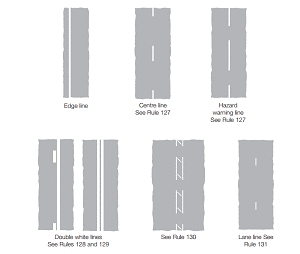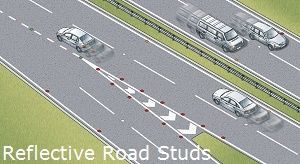UK ROAD MARKINGS AND MEANINGS: What do the arrows, lines, and chevrons mean?
As a rule, the UK Highway Code road markings delineate the center of two-way roads. The white or yellow lines mark the lanes and edges of carriageways.
Highway Code lane markings also highlight areas of highways and streets which you should not cross in a vehicle.
Broken White Lines
Rule 127: Broken white line road markings show the center of the road. This kind of white line road markings run along the middle of the carriageway to delineate the center line.
As a rule there is a hazard ahead if this line lengthens and the gaps shorten. This Highway Code road marking is sometimes called a hazard warning line.
Drivers should not cross a broken white line unless they can see the road is clear. The main reason for motorists to cross over road white lines would be to overtake another vehicle or to turn off the road.
Double White Lines On Road
 Rule 128: Double white lines on the road. If the line nearest to you gets broken it means you may cross the lines to overtake if it is safe.
Rule 128: Double white lines on the road. If the line nearest to you gets broken it means you may cross the lines to overtake if it is safe.
The UK Highway Code road markings regulation for solid white lines indicate you should complete the crossing maneuver before you reach a solid white line along the side of road and on your side of the road.
What if you see white directional arrows on the road? They are indicating that you need to return onto your side of the carriageway.
Rule 129: If there are double white lines and the line nearest to you is solid, it means you MUST NOT cross or straddle it.
The exception is when you need to enter adjoining premises or a side road and it is safe to do so.
You may also cross a double white line, if the road is clear, to pass a stationary vehicle. The same rule applies to overtake a pedal cycle, a horse, or road maintenance vehicle, if they are travelling at 10 mph (16 km/h) or less.
Chevrons Highway Code Rule 130
Rule 130: White diagonal stripes, or Highway Code chevrons, painted on the road separate traffic lanes. Highway Code chevrons on road surfaces also intend to protect traffic that may be turning right.
- If the area gets bordered by broken white line markings, you should not enter the area unless it is necessary and you can see that it is safe to do so.
- If the area gets marked with Highway Code chevrons and bordered by solid white lines they show you MUST NOT enter it except in an emergency.
Lane Dividers Road Markings Meanings
Rule 131: Lane dividers, also known as lane lines, are short, broken white lines. They are usually used on wide carriageways to divide them into lanes. All motorists should keep their vehicle between a short white lane divider road marking.
Reflective Road Studs UK
Rule 132: Reflective road studs may get used with white line markings. They are typically used to mark the lanes and edges of the carriageway.
- White studs mark the lanes or the middle of the road.
- Red studs mark the left edge of the road.
- Amber studs mark the central reservation of a dual carriageway or motorway.
- Green studs mark the edge of the main carriageway at lay-bys and slip roads. You might see green studs on motorway most often.
- Green/yellow studs show temporary adjustments to lane layouts.
Highway Code Single Yellow Line
A single yellow line is a road marking that is present on the side of the carriageway in the United Kingdom. It indicates that parking or waiting at that roadside is prohibited at certain times of day. The exact times vary by area and are indicated by signs at the roadside.
Highway Code Double Yellow Lines
You MUST NOT wait or park on yellow lines during the times of operation shown on nearby time plates (or zone entry signs if in a Controlled Parking Zone). Double yellow lines indicate a prohibition of waiting at any time even if there are no upright signs.
ALSO IN THIS SECTION
Advice about the Highway Code: A guidance section answering many common questions about driving.
Control of the Vehicle: Learn how to brake safely and avoid brakes skidding on wet icy roads.
Highway Code for Children: Road safety guide to teach small children how to stay safe on the streets.
National Speed Limits: Learn the maximum allowances for driving all vehicles in the United Kingdom.
Road Rules and Lane Discipline: Check the UK Highway Code for driving on single and dual carriageways.
Breaking Down on Public Roads: A list of rules and safe procedures for handling emergency incidents.

